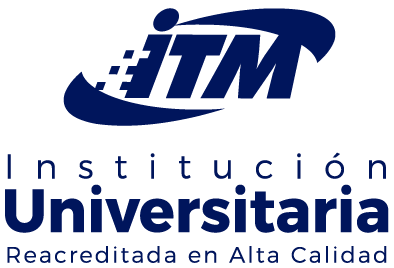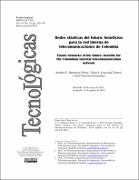| dc.contributor.author | Betancur-Pérez, Andrés F. | |
| dc.contributor.author | Granada-Torres, Jhon J. | |
| dc.contributor.author | Guerrero-González, Neil | |
| dc.date.accessioned | 2019-07-18T14:11:10Z | |
| dc.date.accessioned | 2019-08-20T15:54:34Z | |
| dc.date.available | 2019-07-18T14:11:10Z | |
| dc.date.available | 2019-08-20T15:54:34Z | |
| dc.date.issued | 2015-01-15 | |
| dc.identifier | https://revistas.itm.edu.co/index.php/tecnologicas/article/view/222 | |
| dc.identifier | 10.22430/22565337.222 | |
| dc.identifier.uri | http://hdl.handle.net/20.500.12622/953 | |
| dc.description.abstract | El continuo crecimiento de la demanda de datos está dirigiendo la investigación para dar luz a una red eficiente en el uso de la fibra óptica y el espectro radioeléctrico. La próxima generación de redes será el resultado de una convergencia entre el dominio óptico e inalámbrico para reunir cada una de sus virtudes en una vasta red de telecomunicaciones más resiliente y más simplificada. Colombia no estará marginada de estos avances ya que actualmente despliega fibra óptica por gran parte del territorio nacional y por tal motivo debe estar informada de los progresos actuales en lo referente a redes de telecomunicaciones de nueva generación y orientar de mejor forma los lineamientos legales del ministerio de TIC (Tecnologías de la Información y las Comunicaciones) para traer en consecuencia grandes beneficios a la regulación de la red interna de telecomunicaciones en cuanto a lo decretado acerca de los inmuebles de propiedad horizontal. En este trabajo se plasman los avances en investigación concernientes a transmisiones por fibra óptica, incluyendo el nuevo paradigma de redes híbridas de fibra óptica con redes inalámbricas que permitirán simplificar la red global de telecomunicaciones. Las redes elásticas del futuro sugieren que las redes internas de telecomunicaciones serán más reducidas, simples y versátiles, lo cual facilitará la libre competencia entre los proveedores de servicios de comunicaciones, evitando el monopolio de espacios dentro de edificios de propiedad horizontal. | spa |
| dc.format.mimetype | application/pdf | |
| dc.language.iso | spa | |
| dc.publisher | Instituto Tecnológico Metropolitano (ITM) | spa |
| dc.relation | https://revistas.itm.edu.co/index.php/tecnologicas/article/view/222/228 | |
| dc.rights | Copyright (c) 2017 Tecno Lógicas | spa |
| dc.source | 2256-5337 | |
| dc.source | 0123-7799 | |
| dc.source | TecnoLógicas; Vol 18 No 34 (2015); 125-136 | eng |
| dc.source | TecnoLógicas; Vol. 18 Núm. 34 (2015); 125-136 | spa |
| dc.subject | FI-WI | spa |
| dc.subject | PON | spa |
| dc.subject | redes elásticas | spa |
| dc.subject | redes malla | spa |
| dc.subject | supercanales | spa |
| dc.subject | WDM | spa |
| dc.title | Redes elásticas del futuro: beneficios para la red interna de telecomunicaciones de Colombia | spa |
| dc.title.alternative | Elastic networks of the future: benefits for the Colombian internal telecommunication network | |
| dc.subject.keywords | Elastic networks | eng |
| dc.subject.keywords | FI-WI | eng |
| dc.subject.keywords | mesh networks | eng |
| dc.subject.keywords | PON | eng |
| dc.subject.keywords | superchannels | eng |
| dc.subject.keywords | WDM. | eng |
| dc.type | info:eu-repo/semantics/article | |
| dc.type | info:eu-repo/semantics/publishedVersion | |
| dc.type | Review Article | eng |
| dc.type | Artículos de revisión | spa |
| dc.relation.ispartofjournal | TecnoLógicas | |
| dc.description.abstractenglish | The continuous growth in data demand is leading research to bring to light an efficient network using fiber optics and radioelectric spectrum. The next generation of networks will be the result of a convergence between the optical and wireless domain with the purpose to gather all of their virtues in a vast telecommunications network more resilient and more simplified. Colombia will not be marginalized of these advances because actually has deployed optical fiber in most of the country and therefore they must be informed of current progress in terms of new generation of telecommunications networks and guide in a better way the legal guidelines of the Ministry of ICT (Information and Communications Technology) to bring great benefits to the regulation of internal telecommunications network, concerning what was decreed about the immovable of horizontal property. In this paper, research advances are reflected concerning optical fiber transmission, including the new paradigm of hybrid fiber optic networks with wireless networks that will simplify the global telecommunications network. The elastic networks of the future suggest that internal telecommunications networks will be smaller, simple, and versatile, which will facilitate competition between communication service providers, avoiding the monopoly of spaces within horizontal property buildings. | eng |
| dc.rights.accessrights | info:eu-repo/semantics/openAccess | |
| dc.type.coar | http://purl.org/coar/resource_type/c_6501 | |


